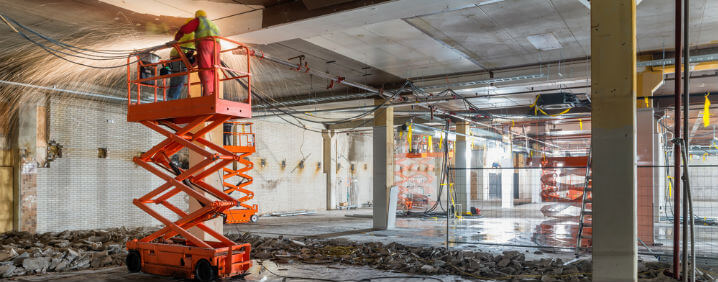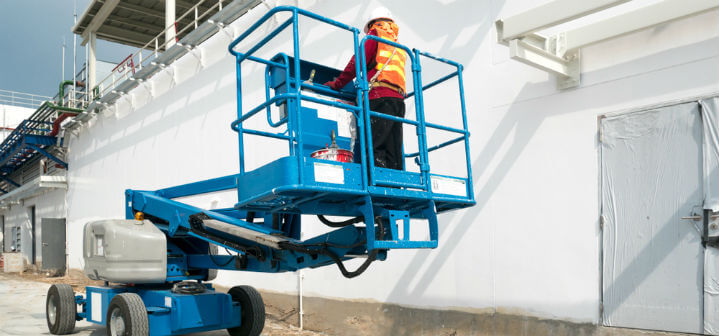Scissor lifts are platforms that are used in multiple industries to move workers vertically. The cross beams work in scissor-like fashion, transporting employees up and down as they complete their tasks. These lifts differ from aerial lifts, which include extendable boom platforms, aerial ladders, and vertical towers.
Today, we’ll dive into the scissor lift inspection OSHA requires. It’s vital that the scissor lift equipment always operates safely and that employees are trained to manage and perform their duties properly while aboard both scissor and aerial lifts.
The Importance of Scissor Lift Inspection
OSHA scissor lift certification requirements, along with aerial lift inspection requirements, cannot be taken lightly. The entire purpose behind such lift equipment is that it has often proven to be safer than traditional ladders and scaffolding. These machines are quite stable yet mobile and flexible. You can’t afford to take their inherent convenience and easy operation for granted.
Scissor lifts are safe and reliable when used in compliance with the manufacturer’s instructions. If your workers aren’t trained, then a series of serious hazards may present themselves.
In a single year, OSHA discovered ten preventable fatalities and over twenty injuries that were the painful and even permanent results of incidents involving scissor lifts alone. The investigation found that employers had failed to comply with the scissor lift safety OSHA set forth via their regulations and proper training.
As you continue reading, you may soon realize that you need assistance in workplace safety training. Our safety consulting firm has helped many companies in their endeavors to be safe, efficient, and organized. We encourage you to make notes as you read our article, and if you have questions along the way, know that our experts at Safety by Design have answers.
OSHA Scissor Lift Training Requirements

The OSHA regulations for scissor lifts center on three aspects: fall protection, stabilization, and positioning. Though these machines are designed to operate with ease, boasting user-friendly controls and smooth transportation for convenient access, only trained workers should be allowed to use the equipment.
The OSHA aerial lift annual inspection requirements, as well as the current OSHA scissor lift requirements, should all be perused, distributed, understood, and practiced daily.
As always, we present the following as a general list of requirements and by no means a comprehensive collection of regulations.
Fall Protection
Scissor lifts must always have guardrails, and because a worker should never be leaning against or standing on the rails, they need to keep their work within easy reach. Guardrails are required to help improve working at height safety in the event of a misstep.
Stabilization
Employers must monitor and ensure that equipment is steady – that no chance of tipping or even collapsing is possible. Firm, level surfaces are required, avoiding obstacles and potential hazards like holes, bumps, and even slight slopes.
All manufacturer’s guidelines must be read and followed. Lifts should never be moved in elevated positions, never be near other moving equipment, and never be operated outdoors during inclement weather. Wind and precipitation are not suitable for stability or maintenance. Further, all safety features designed to stop collapse should be checked regularly.
Positioning
There are two types of hazards covered under this umbrella term: crushing and electrocution. Both dangers are, of course, potentially fatal. Crushing involves trained workers on the lifts and those working nearby. Employees should be watchful whenever the scissor lift is in operation.
Workers should not be working directly underneath or even around the area while the lift is used. All personnel should pay attention to stationary objects near the lift, moving vehicles in the vicinity, and fixed, overhead beams, door frames, tree limbs, overhangs, etc.

Next, positioning the scissor lift to avoid electrocution and burns is vital. Even if a worker isn’t touching an energized pole or line, electricity can pose a danger. Power can leap from wire to the scissor lift or even directly to a worker. It’s imperative that employers monitor traffic and implement controls.
Selecting locations that do not pose the threat of overhead power lines (and within 10 feet, bear no electrical sources at all) is ideal. Workers should complete electrical training if they’re required to work in areas involving live wire, transformers, and other utilities.
It’s a lot of information to digest, organize, maintain, and keep up-to-date. Our safety management software, SafeTeam, could be just what you need to help with such an endeavor.
Scissor Lift Inspection Form
We hope you’ll find our example scissor lift inspection sheet useful. If employers don’t have something like these handy and ready to use each day, they’re failing to be OSHA compliant. There’s no way to assure your workers are safe without a concrete method of checking equipment, limits, surroundings, protective gear, weather conditions, etc.
You’re bound to forget something unless the checkpoints are itemized and physically checked off. A scissor lift daily inspection sheet, along with a scissor lift pre-start checklist, is necessary for smooth, safe workplace tasks.
Click here to examine our scissor lift safety checklist!
Safety by Design makes your and your workers’ safety their priority and mission. Request a consultation today and learn why we’re the leaders in the industry when it comes to assessing companies and designing business-wide efficiency with protection as our primary focus.



